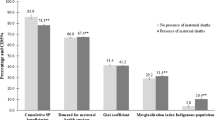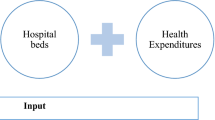Abstract
AIDS is one of the most significant health care problems worldwide. Due to the difficulty and costs involved in treating HIV, preventing infection is of paramount importance in controlling the AIDS epidemic. The main purpose of this paper is to explore the potential of using Data Envelopment Analysis (DEA) to establish international comparisons on the efficiency of implementation of HIV prevention programmes. To do this we use data from 52 low- and middle-income countries regarding the prevention of mother-to-child transmission of HIV. Our results indicate that there is a remarkable variation in the efficiency of prevention services across nations, suggesting that a better use of resources could lead to more and improved services, and ultimately, prevent the infection of thousands of children. These results also demonstrate the potential strategic role of DEA for the efficient and effective planning of scarce resources to fight the epidemic.

Similar content being viewed by others
References
UNAIDS (2010) Global Report: UNAIDS report on the Global Aids Epidemic 2010. Joint United Nations Programme on HIV/AIDS
International HIV/AIDS Alliance (2010) The cost efficiency of HIV prevention for vulnerable and most-at-risk populations and the reality of funding. International HIV/AIDS Alliance
Lasry A, Sansom SL, Hicks KA, Uzunangelov V (2011) A model for allocating CDC’s HIV prevention resources in the United States. Health Care Manag Sci 14:115–124. doi:10.1007/s10729-010-9147-2
Earnshaw SR, Hicks K, Richter A, Honeycutt A (2007) A linear programming model for allocating HIV prevention funds with state agencies: a pilot study. Health Care Manag Sci 10:239–252. doi:10.1007/s10729-007-9017-8
Brandeau ML, Zaric GS, De Angelis V (2005) Improved allocation of HIV prevention resources: using information about prevention program production functions. Health Care Manag Sci 8:19–28
Rauner MS, Brandeau ML (2001) AIDS policy modeling for the 21st century: an overview of key issues. Health Care Manag Sci 4:165–180
Beck EJ, Miner AH (2001) Effectiveness and efficiency in the delivery of HIV services: economic and related considerations. In: Gazzard BG, Johnson M, Miles A (eds) The effective management of HIV/AIDS: UK key advances in clinical practice. Aesculapius Medical Press, London, pp 113–138
Harling G, Wood R, Beck EJ (2005) Efficiency of interventions in HIV infection, 1994–2004. Dis Manag Health Outcome 13(6):371–394
De Cock KM, Fowler MG, Mercier E, de Vincenzi I, Saba J, Hoff E, Alnwick DJ, Rogers M, Shaffer N (2000) Prevention of mother-to-child HIV transmission in resource-poor countries: translating research into policy and practice. J Am Med Assoc 283(9):1175–1182
Appleby J, Thomas A (2000) Measuring performance in the NHS: what really matters? Br Med J 320:1464–1467
Flessa S (2000) Where efficiency saves lives: a linear programme for the optimal allocation of health care resources in developing countries. Health Care Manag Sci 3:249–267
Ozcan YA, Smith P (1998) Towards a science of the management of health care. Health Care Manag Sci 1:1–4
Royston G (1998) Shifting the balance of health care into the 21st century. Eur J Oper Res 105:267–276
Ruiz MS, Gable AR, Kaplan EH, Stoto MA, Fineberg H, Trussell J (eds) (2001) No time to lose: getting more from HIV prevention. National Academy Press, Washington DC
Kaplan EH, Merson MH (2002) Allocating HIV-prevention resources: balancing efficiency and equity. Am J Public Health 92(12):1905–1907
Marseille E, Dandona L, Saba J, McConnel C, Rollins B, Gaist P, Lundberg M, Over M, Bertozzi S, Kahn JG (2004) Assessing the efficiency of HIV prevention around the world: methods of the PANCEA project. Health Serv Res 39(6):1993–2012
Charnes A, Cooper WW, Rhodes EL (1978) Measuring the efficiency of decision making units. Eur J Oper Res 2:429–444
Banker RD, Charnes A, Cooper WW (1984) Some models for estimating technical and scale inefficiencies in data envelopment analysis. Manag Sci 30:1078–1092
Cooper WW, Seiford L, Tone K (2000) Data envelopment analysis: a comprehensive text with models, applications, references and DEA-solver software. Kluwer, Massachusetts
Cooper WW, Seiford L, Zhu J (2004) Handbook on data envelopment analysis. Kluwer, Massachusetts
Ozgen H, Ozcan YA (2004) Longitudinal analysis of efficiency in multiple output dialysis markets. Health Care Manag Sci 7:253–261
O’Neill L, Dexter F (2004) Market capture of inpatient perioperative services using DEA. Health Care Manag Sci 7:263–273
Langabeer JR, Ozcan YA (2009) The economics of cancer care: longitudinal changes in provider efficiency. Health Care Manag Sci 12:192–200. doi:10.1007/s10729-008-9079-2
Hollingsworth B, Dawson PJ, Maniadakis N (1999) Efficiency measurement of health care: a review of non-parametric methods and applications. Health Care Manag Sci 2:161–172
Hollingsworth B (2003) Non-parametric and parametric applications measuring efficiency in health care. Health Care Manag Sci 6:203–218
Chilingerian JA, Sherman HD (2004) Health care applications: from hospitals to physicians, from productive efficiency to quality frontiers. In: Cooper WW, Seiford LM, Zhu J (eds) Handbook on data envelopment analysis. Kluwer, London, pp 481–537
Hollingsworth B (2008) The measurement of efficiency and productivity of health care delivery. Health Econ 17:1107–1128
Zanakis SH, Alvarez C, Li V (2007) Socio-economic determinants of HIV/AIDS pandemic and nations efficiencies. Eur J Oper Res 176:1811–1838
Beck EJ (1991) HIV infection and intervention: the first decade. AIDS Care 3(3):295–302
Piot P, Zewkie D, Türmen T (2002) HIV/AIDS prevention and treatment. Lancet 360:86
UNAIDS (2005) Q&A II: selected issues: prevention, care and funding - UNAIDS Questions & Answers. Joint United Nations Programme on HIV/AIDS
Bryson YJ (1996) Perinatal HIV-1 transmission: recent advances and therapeutic Interventions. AIDS 10(Supplement 3):S33–S42
Zachariah R, Harries AD, Luo C, Bachman G, Graham SM (2007) Scaling-up co-trimoxazole prophylaxis in HIV-exposed and HIV-infected children in high HIV-prevalence countries. Lancet Infect Dis 7(10):686–693
Marseille E, Kahn JG, Mmiro F, Guay L, Musoke P, Fowler MG, Jackson JB (1999) Cost effectiveness of single-dose nevirapine regimen for mothers and babies to decrease vertical HIV-1 transmission in sub-Saharan Africa. Lancet 354(9181):803–809
Quinn T (1996) Global burden of the HIV pandemic. Lancet 348:99–106
Jones SA, Sherman GG, Varga CA (2005) Exploring socio-economic conditions and poor follow-up rates of HIV-exposed infants in Johannesburg, South Africa. AIDS Care 17(4):466–470
Msellati P (2009) Improving mothers’ access to PMTCT programs in West Africa: a public health perspective. Soc Sci Med 69:807–812
Coovadia HM, Hadingham J (2005) HIV/AIDS: global trends, global funds and delivery bottlenecks. Global Health 1:1–13
Little K, Thorne C, Luo C, Bunders M, Ngongo N, McDermott P, Newell M (2007) Disease progression in children with vertically-acquired HIV infection in sub-Saharan Africa: reviewing the need for HIV treatment. Curr HIV Res 5:139–153
de Castella T (2003) Health workers struggle to provide care in Zimbabwe. Brain drain adds to woes of a cash-strapped healthcare system. Lancet 362:46–47
Kaufmann D, Kraay A, Mastruzzi M (2010) The worldwide governance indicators: methodology and analytical issues. World Bank Policy Research Working Paper N.º 5430. http://papers.ssrn.com/sol3/papers.cfm?abstract_id=1682130
Ali AI, Seiford LM (1990) Translation invariance in data envelopment analysis. Oper Res Lett 9:403–405
Kuosmanen T (2002) Modelling blank data entries in data envelopment analysis. Econ-WPA working paper at WUSTL, n.º 0210001 (Econometrics), available from: http://ideas.repec.org/p/wpa/wuwpem/0210001.html
Emrouznejad A, Thanassoulis E (2005) Performance improvement management. DEASoft, Pim Ltd
Marseille E, Dandona L, Marshall N, Gaist P, Bautista-Arredondo S, Rollins B, Bertozzi SM, Coovadia J, Saba J, Lioznov D, Du Plessis J, Krupitsky E, Stanley N, Over M, Peryshkina A, Kumar SG, Muyingo S, Pitter C, Lundberg M, Kahn JG (2007) HIV prevention costs and program scale: data from the PANCEA project in five low and middle-income countries. BMC Health Serv Res 7(1):108. doi:10.1186/1472-6963-7-108
Brandeau ML, Zaric GS (2009) Optimal investment in HIV prevention programs: more is not always better. Health Care Manag Sci 12:27–37. doi:10.1007/s10729-008-9074-7
Hollingsworth B, Smith PC (2003) Use of ratios in data envelopment analysis. Appl Econ Lett 10(11):733–735
Sarrico CS, Dyson RG (2004) Restricting virtual weights in data envelopment analysis. Eur J Oper Res 159(1):17–34
Cooper W, Ruiz J, Sirvent I (2007) Choosing weights from alternative optimal solutions of dual multiplier models in DEA. Eur J Oper Res: 443–458
World Health Organization (2006) Honduras—The country cooperation strategy brief. Available online at: http://www.who.int/countries/hnd/en/ Accessed on 24/11/11
World Health Organization (2010) El Salvador—the country cooperation strategy brief. Available online at: http://www.who.int/countries/slv/en/ Accessed on 24/11/11
World Health Organization (2011) Global HIV/AIDS response: epidemic update and health sector progress towards universal access: Progress Report 2011
UNICEF (2007) Press Centre. News note: more than four million mothers and children to benefit during Madagascar’s third ‘Mother and Child Health Week’. Antananarivo, 30 October 2007. Available online at: http://www.unicef.org/infobycountry/media_41498.html Accessed on 24/11/11
Family Health International (2007) Promising and best practices in HIV/AIDS prevention and care for West and Central Africa. Family Health International, Durham, NC http://www.fhi.org/en/HIVAIDS/pub/guide/res_BestPracticesPreventionCare.htm
Welty T, Bulterys M, Welty ER, Tih PM, Ndikintum G, Nkuoh G, Nkfusai J, Kayita J, Nkengasong JN, Wilfert CM (2005) Integrating prevention of mother-to-child HIV transmission into routine antenatal care: the key to program expansion in Cameroon. J Acquir Immune Defic Syndr 40(4):486–493
Bolu OO, Allread V, Creek T, Stringer E, Forna F, Bulterys M, Shaffer N (2007) Approaches for scaling up human immunodeficiency virus testing and counselling in prevention of mother-to-child human immunodeficiency virus transmission settings in resource-limited countries. Am J Obstet Gynecol 197:S83–S89
Wanyu B (2007) Birth attendants trained in “Prevention of Mother-To-Child HIV transmission” provide care in rural Cameroon, Africa. J Midwifery Womens Health 52(4):334–341
Ministère de la Santé et de l’Hygiène Publique (2000) Manuel des directives du paquet minimum d’activités des établissemenst sanitaires de premier contact. Ministère de la Santé et de l’Hygiène Publique, Rébublique de Côte d’Ivoire, Abidjan
Ministère de la Santé et de l’Hygiène Publique (2006) Politique Nationale de Prévention de la Transmission du VIH de la mère à l’enfant en Côte d’Ivoire. Ministère de la Santé et de l’Hygiène Publique, Rébublique de Côte d’Ivoire, Abidjan
Pedraja-Chaparro F, Salinas-Jiménez J, Smith P (1999) On the quality of the data envelopment analysis model. J Oper Res Soc 50(6):636–644
Anderson P, Petersen NC (1992) A procedure for ranking inefficient units in data envelopment analysis. Manag Sci 39(10):1261–1264
Acknowledgement
The authors thank the anonymous reviewers for the insightful comments and helpful suggestions. We also would like to thank Graeme Doherty for useful comments during the preparation of this paper. Funding support for this research was provided by Fundação para a Ciência e a Tecnologia (FEDER/POCI2010).
Author information
Authors and Affiliations
Corresponding author
Appendix
Appendix
Multiplier version of the DEA model used in the analysis (includes one weight restriction)
Subject to:
Where E 0 is the relative efficiency of DMU 0 , X i0 is the quantity of Input i used by DMU 0 (with i = 1 … 5) and Y r0 the quantity of Output r produced by DMU 0 (with r = 1, …, 4), V i is the weight attributed to Input i, U r is the weight attributed to Output r, and w 0 is the scale variable for DMU 0 .
Rights and permissions
About this article
Cite this article
Santos, S.P., Amado, C.A.E. & Santos, M.F. Assessing the efficiency of mother-to-child HIV prevention in low- and middle-income countries using data envelopment analysis. Health Care Manag Sci 15, 206–222 (2012). https://doi.org/10.1007/s10729-012-9196-9
Received:
Accepted:
Published:
Issue Date:
DOI: https://doi.org/10.1007/s10729-012-9196-9




